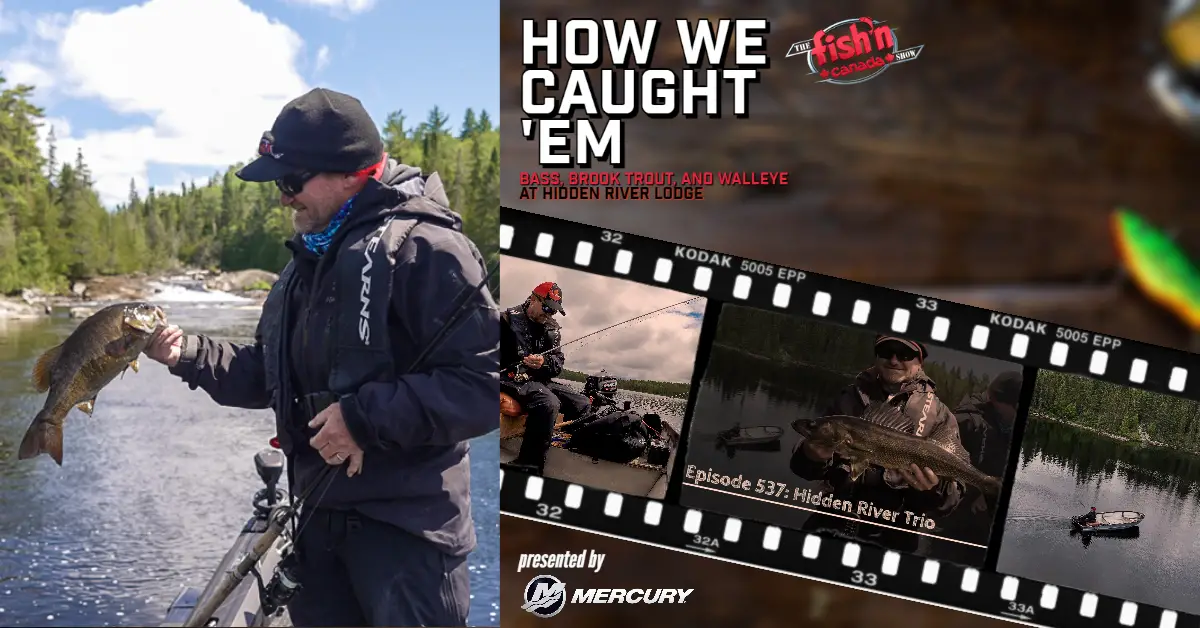Sponsored by Mercury
This shoot was a unique, three-location shoot that I travelled to on a solo mission. The location was Hidden River Lodge on Whitefish Lake just out of Hawk Junction near Wawa Ontario. The three fish species I was after were Brook Trout, Smallmouth Bass, and Walleye.
Location 1 – Brookies
I love a good scrap with a speedy little turbo-charged fish like a Brook Trout. Kinda reminds me of… never mind! Let’s just say a wee ball of fire and leave it at that.
At this off-site location (not the lodge lake) we decided to put in half a day to see if we could pop a couple of brookies. Lakes like these in the Algoma country honestly inspire me and keep me coming back for more every season.
For this lake, we simply did as I normally do on a strange waterbody, and that is trolling. There are three bait types I use in this situation, spinners, spoons, and minnow baits. This day turned into a spoon bite (two other anglers on the lake verified it for me).
My setup here was a 7-foot light action spinning rod coupled with a 1000-size reel. In this instance, I’d highly recommend moving up to a 2000 or 2500 spinning reel (I didn’t bother changing as my rig was already tied up) as they are quicker to reel in. Brook Trout are notorious for peeling out lots of drag and then suddenly, turning 180 degrees and charging the boat. And there’s nothing you can do about it but reel as fast as you can. Bigger is better here.
For my bait, I was using a Little Cleo spoon in copper/red colour. For some reason that is unknown to me, that little colour combo is the bomb for these little Brookie lakes.
Add a few of these in various sizes to your Brookie box… trust me!
I had my usual 10-pound test braid attached to an 8-pound fluorocarbon leader, and a snap/swivel combination since spoons will eventually twist your line.
For speed, I simply look out over the side of the boat and watch my spoon work. I always try to go as slow as the boat will troll and then speed up from there if necessary. A nice wobble is all you need with a spoon.
That afternoon turned out to be a success with me catching a couple of gorgeous Specks.
They are such cool fish!
Location 2 – Smallmouth Bass
Number two on my list was the almost furthest boat ride I could make on this body of water. The extreme north end of Whitefish and Manitowik lakes has two beautiful incoming rivers. And with incoming, moving water, comes oxygen, zooplankton, minnows, and game fish. And trust me when I tell you, they were all there. Smallmouth Bass, Walleye, Northern Pike, and minnows galore.
I was after, of course (as you see in the pic), Smallmouth. Now it’s not often I say the fishing was pretty much a no-brainer but, in this spot, it was. My biggest problem was the smaller fish hitting my baits before the bigger ones could get it.
I had two rigs that worked really well here. First was a light crankbait rod and reel. The rod is a 7-foot graphite rod (normally not “recommended” for crankbaits, a glass composite or all glass is more popular) with a really light action. I love it for small crankbaits… so much fun. I couple that with a small baitcast reel, a perfect match. It’s almost reminiscent of the new BFS set-ups out there now that are getting popular (only mine is so OLD SCHOOL).
To that, I spool 10 pound test Yo-Zuri T7 Premium 100% Fluorocarbon line. That, or their Mainline 100% fluorocarbon both work great for crankbaits. I use fluorocarbon on my crankbaits because it sinks and seems to have the perfect amount of stretch. Mono is too spongy and braid is way too stiff… but that’s for me. You and others may be different.
The crankbaits that I used up in that flowing water were Yo-Zuri both in the 3DB line-up, one being the 1.5 MR (Medium Runner) and the other the 1.5 Squarebill. I played with colours, it didn’t seem to matter all that much.
My second bait of choice was a Ned rig. I actually used the exact same rods that I did for the Brook Trout above, light action with 10lb braid to 8lb fluorocarbon leader material.
My Neds were Z Man TRD’s as well as cut down 4” Yamamoto Senkos on ⅛ to 1/16 ounce heads.
A Ned Rig is one of the deadliest Smallmouth presentations out there
BTW, I caught some incidental Walleye up there and a couple of Northern Pike. What a location that is (look for this episode called Hidden River Trio on our website’s TV section or on our YouTube channel, we have the GPS coordinates too)
Location 3 – Walleye
This portion of the shoot brought back some great memories for me. In talking to lodge owner Matt Risko, he highly recommended Slip Bobber fishing for some finicky Walleye up the lake. I was instantly in. I love using some kind of float for species of fish that aren’t normally associated with float fishing.
My setup included a 7’ medium action spinning rod along with a 2500 size reel, spooled up with 8-pound T7 Fluorocarbon. I used straight fluoro here. Had I used my typical spinning setup of braid to fluoro leader, the knot that is needed to join fluoro to braid would hinder the float from slipping down to the jig.
Speaking of which, a slip float rig consists of a float or bobber stopper, a sliding float (hole directly up the center) and normally a jighead and some kind of live bait. On this shoot, it was live leeches.
A slip float, a stopper and a jig head are all you need to get started in this deadly technique
Sometimes an added small egg sinker helps get a bait further out and down, but I didn’t have to use one here.
Essentially, the float and jig sit at the end (bottom if you will) of the line when the rig is out of the water. The bobber stop is a set length (determined by you the angler) up the line, as to how deep you want that jig to drop to. In being set up like this, the bobber and jig can be easily cast out and then the jig drops to its set depth and the line is halted by the stopper. Sounds a bit complicated but it’s a simple design.
This trip was a perfect situation for using a slip float. The Walleye were finicky and they were tucking themselves into weird little hard-to-hit places. One, in particular, was a little indent in a big boulder. There was no way I could cast a moving bait like a crankbait, a minnow bait, a spinner, etc. If I were to try a regular jig and live bait, I would have snagged on every third cast. The slip float put my bait directly in front of the Walleye.
Now, right about now some of you are saying “how does he know that” right?
Check out the little pod of Walleye hiding behind this rock
I could see them as plain as day on my LiveScope forward viewing screen. I could even tell how many fish were in the school at any given time. I could also tell when they left that particular area. This is so important in using your time wisely on the water.
Longish story short, I stayed in tune with a few different schools of Walleye by scoping them and pretty much every time I could get a good cast to those fish, one would hit.
Very efficient and effective.







2 Responses
Sure Luv Them Brookies
Facebook
Instagram
Twitter
Youtube
Pete Bowman
Brookies rock bud!!!!